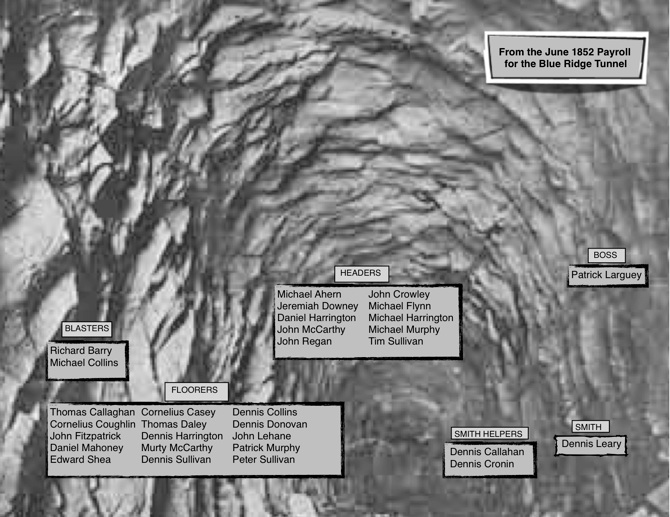Clann Mhór

Payroll Records for the Blue Ridge Tunnel
When the Blue Ridge Railroad issued contracts for the various sections of the seventeen miles of track, the contractors agreed to a “fixed price” contract to perform the work required. The contractors would then invoice the Railroad monthly for the actual work completed with the dollar value based on agreed unit prices. The actual labor and material costs to the contractor was not a concern of the Railroad. As typically done today, the payroll and material ledgers were kept by the contractors. Clann Mhór has not been able to find records of the various contractors, such as Kelly and Larguey, Mordecai & Sizer, Gallaher & McElroy, or T.J. Randolph. However, the work at the Blue Ridge Tunnel proved so difficult, the Railroad agreed to terminate the original contract with Kelly and Larguey, and continue the work under a “cost plus” basis, whereby the Railroad would keep track of the actual costs, and then pay those expenses plus a fee to Kelly & Larguey. Thus the Railroad, on behalf of the Virginia Board of Public Works, hired clerks to document the daily labor and material expenses.
The Library of Virginia has the actual ledger with the payroll costs incurred starting in early 1852 and extending to March of 1857. Each sheet of the ledger lists the employees, their work classification, the days of the month worked, their rate of pay and the total earnings for the month. Further, the payroll shows the separate crews working on the East and West side of the mountain. With this payroll ledger, one can see the names of the hundreds of Irish workers and the many slaves who worked on the tunnel and its approaches. One can see how new crews were added or when other names were dropped off the payroll. The ledger shows when the entire crew took off for holidays or funerals, and how some men worked two shifts a day. When the cholera hit in the summer of 1854, the records show that the work force left for several weeks. As manpower availability changed, the wage rates would rise and sometimes fall.



Clann Mhór has transcribed this ledger, and the spreadsheet can be sorted in a number of ways to better understand the work of these crews who spent eight years tunneling through the mountain. It clearly documents the long hard work of the men. More than anything, these payroll records enshrine the names of the laborers themselves.

A typical crew working on the East side of the tunnel in June 1852
